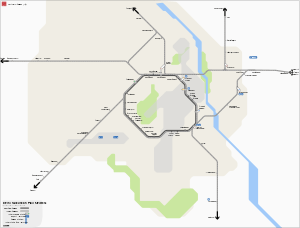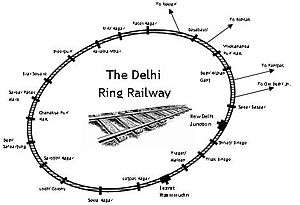Delhi Suburban Railway
Delhi Suburban Railway is a suburban rail service operated by Northern Railway for the National Capital Region. This railway service covers Delhi, along with the adjoining districts of Faridabad, Ghaziabad, Sonipat and other adjoining places in Haryana and Uttar Pradesh. These services are mostly run using EMU and MEMU rakes. This also includes passenger trains and DMU services up to Rewari in Haryana, which is also considered part of the National Capital Region. Delhi itself has 46 Railway Stations.
| Overview | |||
|---|---|---|---|
| Locale | National Capital Region, India | ||
| Transit type | Suburban Rail | ||
| Operation | |||
| Operator(s) | Northern Railway | ||
| Technical | |||
| Track gauge | 1,676 mm (5 ft 6 in) broad gauge | ||
| |||
According to the railway ministry, plans are under way to renovate and integrate the network with the Delhi Metro through construction of interchanges with metro stations. The project is aimed to reduce congestion in the city.[1]
Facilities
Delhi Suburban Railway uses the same tracks that are also used for long distance trains. In 2009 Ladies Special trains were introduced between New Delhi and Palwal and from New Delhi to Ghaziabad and Panipat.[2]
Timetable
The services are currently available on the following routes.
- Ghaziabad - Old Delhi - New Delhi - Faridabad - Palwal - Kosikalan EMU
- Ghaziabad - Old Delhi - New Delhi - Faridabad - Palwal EMU
- Ghaziabad - Old Delhi - New Delhi - Faridabad - Palwal - Kosikalan - Mathura
- Ghaziabad - Old Delhi - New Delhi EMU
- Ghaziabad - Anand Vihar - New Delhi - Faridabad - Palwal EMU
- H Nizamuddin - Faridabad - Palwal - Kosi Kalan EMU
- New Delhi - Palwal EMU
- New Delhi - Shakurbasti EMU
- Shakurbasti - Old Delhi - Ghaziabad - Dankaur EMU
- Shakurbasti - Old Delhi - New Delhi - H.Nizamuddin - Faridabad - Palwal EMU
- Shakurbasti - New Delhi - Ghaziabad - Khurza - Aligarh EMU
- Shakurbasti - New Delhi - Fardabad - Ballabgarh EMU
- Shakurbasti - Old Delhi - New Delh - H Nizamuddin - Faridabad - Palwal - Mathura EMU
Passenger and DMU services
- Old Delhi-Gurgaon–Rewari DMU
- Old Delhi - Muzaffarnagar EMU
- Old Delhi - Baraut DMU
- Old Delhi - Shamli DMU
- Old Delhi - Rohtak MEMU
At present, EMUs in Delhi run with 12 coaches, of which ten are general compartments and two are ladies compartment. As per the Northern Railway estimates, there are more than 110 suburban trains, which ply on important sections.
Delhi Ring Railway
| Delhi Ring Railway | |||||||||||||||||||||||||||||||||||||||||||||||||||||||||||||||||||||||||||||||||||||||||||||||||||||||||||||||||
|---|---|---|---|---|---|---|---|---|---|---|---|---|---|---|---|---|---|---|---|---|---|---|---|---|---|---|---|---|---|---|---|---|---|---|---|---|---|---|---|---|---|---|---|---|---|---|---|---|---|---|---|---|---|---|---|---|---|---|---|---|---|---|---|---|---|---|---|---|---|---|---|---|---|---|---|---|---|---|---|---|---|---|---|---|---|---|---|---|---|---|---|---|---|---|---|---|---|---|---|---|---|---|---|---|---|---|---|---|---|---|---|---|---|
| Overview | |||||||||||||||||||||||||||||||||||||||||||||||||||||||||||||||||||||||||||||||||||||||||||||||||||||||||||||||||
| Type | Suburban Rail | ||||||||||||||||||||||||||||||||||||||||||||||||||||||||||||||||||||||||||||||||||||||||||||||||||||||||||||||||
| System | Delhi Suburban Railway | ||||||||||||||||||||||||||||||||||||||||||||||||||||||||||||||||||||||||||||||||||||||||||||||||||||||||||||||||
| Locale | Delhi, India | ||||||||||||||||||||||||||||||||||||||||||||||||||||||||||||||||||||||||||||||||||||||||||||||||||||||||||||||||
| Termini | Hazrat Nizamuddin Hazrat Nizamuddin | ||||||||||||||||||||||||||||||||||||||||||||||||||||||||||||||||||||||||||||||||||||||||||||||||||||||||||||||||
| Daily ridership | 3,700 | ||||||||||||||||||||||||||||||||||||||||||||||||||||||||||||||||||||||||||||||||||||||||||||||||||||||||||||||||
| Operation | |||||||||||||||||||||||||||||||||||||||||||||||||||||||||||||||||||||||||||||||||||||||||||||||||||||||||||||||||
| Opened | 1975 | ||||||||||||||||||||||||||||||||||||||||||||||||||||||||||||||||||||||||||||||||||||||||||||||||||||||||||||||||
| Operator(s) | Northern Railway | ||||||||||||||||||||||||||||||||||||||||||||||||||||||||||||||||||||||||||||||||||||||||||||||||||||||||||||||||
| Character | At Grade | ||||||||||||||||||||||||||||||||||||||||||||||||||||||||||||||||||||||||||||||||||||||||||||||||||||||||||||||||
| Technical | |||||||||||||||||||||||||||||||||||||||||||||||||||||||||||||||||||||||||||||||||||||||||||||||||||||||||||||||||
| Line length | 35 km (22 mi) | ||||||||||||||||||||||||||||||||||||||||||||||||||||||||||||||||||||||||||||||||||||||||||||||||||||||||||||||||
| Track gauge | 1,676 mm (5 ft 6 in) broad gauge | ||||||||||||||||||||||||||||||||||||||||||||||||||||||||||||||||||||||||||||||||||||||||||||||||||||||||||||||||
| |||||||||||||||||||||||||||||||||||||||||||||||||||||||||||||||||||||||||||||||||||||||||||||||||||||||||||||||||
Delhi Ring Railway is part of the Delhi Suburban Railway services. The Ring Railway is a circular rail network in Delhi, which runs parallel to the Ring Road and was conceived during the 1982 Asian Games. Started in 1975 to service goods, it later upgraded for the Games, when 24 additional services were started. Its circular route is 35 km (22 mi) long, which the train takes 90–120 minutes to complete, both clockwise and anti-clockwise, via Hazrat Nizamuddin Railway Station, from 8am-7pm. With a return ticket for the entire journey costing ₹12, compared to with Delhi Metro, which is around ₹60, it is preferred by poor and middle-class families.[3] It runs seven clockwise and six anti-clockwise trains at a peak frequency of 60-90 min., during the morning and evening rush hours. Prior to the 2010 Commonwealth Games, 7 stations near the sports venues, namely Chanakyapuri, Sarojini Nagar, Inderpuri Halt, Lajpat Nagar, Sewa Nagar, Lodhi Colony and Safdarjung, received a facelift at the cost of ₹3 crores.[4][5]
The ring-railway service was introduced on a track laid in 1975 so that the large number of goods trains originating, terminating, or passing through the city, could bypass the main passenger stations at New Delhi, Old Delhi and Hazrat Nizamuddin.[5] The track was called the 'Delhi Avoiding Line'. Today, however, the Northern Railway's service for passengers within the city has become something which Delhiites are avoiding. There are 12 electric trains on the ring rail. Only three of the twelve EMUs run to full capacity. The rest have just 1-2% occupancy. The ring railway starts and ends at the Hazrat Nizamuddin Railway Station with trains running in both clockwise and anti-clockwise directions around the city.
Popularity with commuters
The system is not popular among individual travelers and has been a total failure as far as public transport is considered. Delhi Ring Railway is considered as an example of failed mass transit system. The major reasons for failure of the system are lack of workable connections to other methods of transportation as well as a low-density population in the areas of reach. Making matters worse, the station exits usually open into narrow, dirty alleyways - often more than a kilometer away from the main road.
The network is now utilized as a freight corridor, though limited passenger EMU train services are available during peak hours.
Future development
With Delhi Metro growing at a rapid pace, there has been very little focus to improve the condition of the Delhi Suburban Railway. There have been reports of strengthening the services so that more commuters can avail themselves of the facility. Feasibility studies have also been done, and in deference to the commuter demand, there were also plans to start EMU services from Gurgaon. An integrated rail-bus transit (IRBT) system to connect Delhi with the satellite towns of Gurgaon, Ghaziabad, and Sahibabad is being promoted by the government.[6] A feasibility study has already been completed, and a steering committee has been appointed to monitor the project. The IRBT will have two dedicated tracks.
See also
Fleet gallery
References
- https://www.hindustantimes.com/delhi-news/decongesting-delhi-mega-plan-to-link-capital-s-ring-rail-metro-network/story-Lf0h4yaFYj1jOUQtERYDgI.html
- "Delhiites can ride a new train to Bengal this puja". 31 August 2009. Retrieved 1 September 2014.
- "The road around progress". Mint. 17 February 2012.
- "Changing Delhi map makes Ring Railway redundant". Indian Express. 22 February 2011.
- "Ring Rail service chugs into oblivion". Deccan Herald. 4 February 2012.
- "IRBT system to connect the Indian capital, Delhi". International Railway Journal. 2004.

